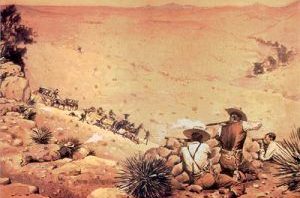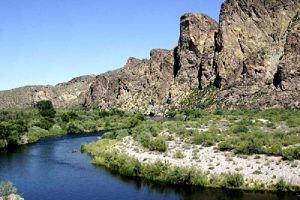buffalo soldiers

 Seldom does it happen that money from a robbery is never recovered, but that is the case for approximately $28,000 in gold and silver coins, which have been missing for more than a century. The money came from the little known Wham Paymaster Robbery, which occurred near Pima, Arizona. Eight suspects were caught and tried for the crime, but in the end, they walked away free men. The circumstances of the robbery remain an unsolved mystery to this day. The robbery of US Army Paymaster, Major Joseph Washington Wham occurred on May 11, 1889 in the early morning hours. Wham was preparing to make the trip from Fort Grant to Fort Thomas to pay the soldiers’ salaries. The day before, he had distributed the pay to Fort Grant. That day, he was to pay the men at Fort Thomas, Camp San Carlos, and Fort Apache.
Seldom does it happen that money from a robbery is never recovered, but that is the case for approximately $28,000 in gold and silver coins, which have been missing for more than a century. The money came from the little known Wham Paymaster Robbery, which occurred near Pima, Arizona. Eight suspects were caught and tried for the crime, but in the end, they walked away free men. The circumstances of the robbery remain an unsolved mystery to this day. The robbery of US Army Paymaster, Major Joseph Washington Wham occurred on May 11, 1889 in the early morning hours. Wham was preparing to make the trip from Fort Grant to Fort Thomas to pay the soldiers’ salaries. The day before, he had distributed the pay to Fort Grant. That day, he was to pay the men at Fort Thomas, Camp San Carlos, and Fort Apache.
Wham, along with his clerk, William Gibbon, and Private Caldwell, his servant and mule tender, climbed into a canopied wagon driven by Buffalo Soldier, Private Hamilton Lewis for the 46 mile trip to Fort Thomas. The payroll Wham was still in possession of was more than $28,000 in gold and silver coins. It was locked in an oak strongbox in the wagon. Given the amount of money Wham was carrying, he was heavily escorted by nine Buffalo Soldiers of the 24th Infantry on horseback, as well as a wagon that carried two privates of the 10th Cavalry (also an African-American regiment) that was driven by a civilian employee of the Quartermaster Department. Everyone was heavily armed, except Wham, his clerk and the two drivers. An African-American female gambler named Frankie Campbell, joined them at the last minute. She wanted to ride along with them to be in Fort Thomas when the soldiers got paid…to stir up a game or two, I’m sure.
About 15 miles west of Pima in the Gila River Valley, just after midday, the caravan came to a stop. A large boulder was blocking the road, and the wagons were unable to get around it. The soldiers lay down their weapons in order to dislodge the large rock. They barely got started when a cry came from a ledge some 60 feet above on the adjacent hill, “Look out, you black sons of bitches!” and bullets began to hail down upon the soldiers. Three of the 12 mules pulling the wagons were killed and the other animals panicked, rearing and pulling both vehicles off the road. The soldiers ran for their guns and took cover to fight the barrage of bullets raining down on them from the hills. Sergeant Benjamin Brown was shot but continued to return fire with his revolver. Private James Young ran through heavy gunfire and carried Brown more than 100 yards to safety. Corporal Isaiah Mays then took command, ordering the entourage to retreat to a creek bed about 300 yards away, while Major Wham strongly protested. The battle continued to rage on for about a half an hour as the soldiers valiantly tried to protect the payload. However, eight of Wham’s eleven-man escort were severely wounded and the battle had become extremely one-sided. During all this, gambler, Frankie Campbell, who had been riding ahead of the caravan, had been thrown from her horse and had taken cover.
With the soldiers hidden, wounded, and severely out gunned, five bandits then made their way to the wagon. Once there, they cracked the strongbox with an ax, and carried off the U.S. Treasury sacks filled with the coins. The soldiers counted 12 outlaws, who made their escape. At about 3:00pm those, who could manage, made their way from the creek bed to the wagons. They spliced harnesses together, gathered some of the surviving mules, and finally made their way to Fort Thomas, arriving about 5:30pm. The soldiers left, Frankie Campbell to tend to the severely wounded, including Sergeant Benjamin Brown. These men would be brought in later. Amazingly, all of the soldiers would survive their wounds, so she must have done a good job with their care.
Amazingly, several of the bandits, who had not thought to cover their faces during the gun battle, were recognized and very soon arrested. US Deputy Marshal William Kidder Meade, and the Graham County Sheriff arrested 11 men, most of whom were citizens of Pima, Arizona. Seven were bound over for trial. The men were Gilbert Webb, the Mayor of Pima at the time. Webb was the suspected leader of the gang. Also arrested was his son, Wilfred. These men were already suspected of numerous thefts in the area. Along with the Webbs, brothers Lyman and Warren Follett, as well as David Rogers, Thomas Lamb, and Mark Cunningham, all of whom worked as cowboys for Gilbert Webb. Strangely, the men were charged with the robbery, but no one was ever charged with the shooting.
The trial in Federal Court in Tucson was held in November lasted 33 days. It was big news in the Southwest. With all the witnesses, I cant figure out how they could not be found guilty, but from the beginning, the trial involved major politics and infighting, including removing the original judge. In all, 165 witnesses testified at the trial, including five Buffalo Soldiers who identified three of the accused. Another witness testified that he had personally seen some of the men hiding the loot in a haystack and burning the US treasury sacks. Several other witnesses testified that they had seen members of the accused in the area of the ambush the day before…probably setting up their “hideouts” from which the ambush took place. Strangely, Frankie Campbell, who had stated she recognized several of the bandits, including the leader, Gilbert Webb, was never called to testify. The defense lawyer was the famed Marcus Aurelius Smith, and in the end all of the men were acquitted.
Afterward, it was widely claimed that political pressure from the acting governor allowed the thieves to go free. The entire case was a hotbed of religion, racism, and politics, as Pima, Arizona was founded as a Mormon Colony, of which Gilbert Webb was the mayor, one of the most influential men in the area, and came from a long line of pioneer Mormons. He was also known in the area as a generous man, providing jobs for struggling neighbors, extending credit, and providing provisions. Though most of the other accused men were not Mormons, they all lived in the Mormon colony, having many ties to the church through friends and relatives. Be it politics or religion, a great injustice was done that day. Many locals viewed the robbery and trial as an embarrassing disgrace to the town and its people, and to talk about it about might offend friends or neighbors, or bring shame upon the colony. Therefore, the robbery was kept largely under wraps. The locals called the robbers “Latter-Day Robin Hoods.”
In the meantime, Major Joseph Washington Wham, as the commanding officer, was held accountable for the loss of the money but was later absolved of any guilt. Two of the Buffalo Soldiers were awarded the Medal of Honor for their part in the gun battle with the bandits. Although shot in the abdomen, Sergeant Benjamin Brown continued the fight until he was further wounded in both arms. Corporal Isaiah Mays also received the Medal of Honor, as near the end of the gun battle, though shot in the legs, he “walked and crawled two miles to Cottonwood Ranch and gave the alarm.” Other Buffalo Soldiers cited for bravery in the incident received the Certificate of Merit. These included Hamilton Lewis, Squire Williams, George Arrington, James Wheeler, Benjamin Burge, Thomas Hams, James Young, and Julius Harrison of the 10th Cavalry and 24th Infantry. US 
 Deputy Marshal Meade, who would bring in the bandits, would say of the soldiers, “I am satisfied a braver or better defense could not have been made under like circumstances.” Throughout the years, the robbery has created a number of various treasure tales, suggesting that some of the coins are still hidden in the area somewhere. However; with all of the suspects set free, this would seem doubtful.
Deputy Marshal Meade, who would bring in the bandits, would say of the soldiers, “I am satisfied a braver or better defense could not have been made under like circumstances.” Throughout the years, the robbery has created a number of various treasure tales, suggesting that some of the coins are still hidden in the area somewhere. However; with all of the suspects set free, this would seem doubtful.

